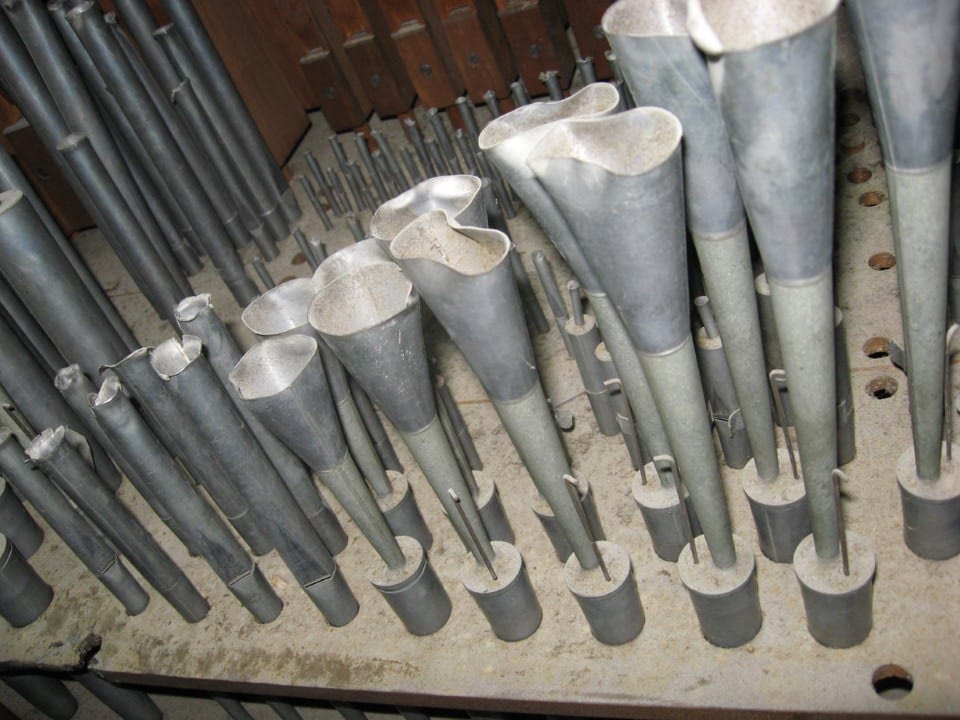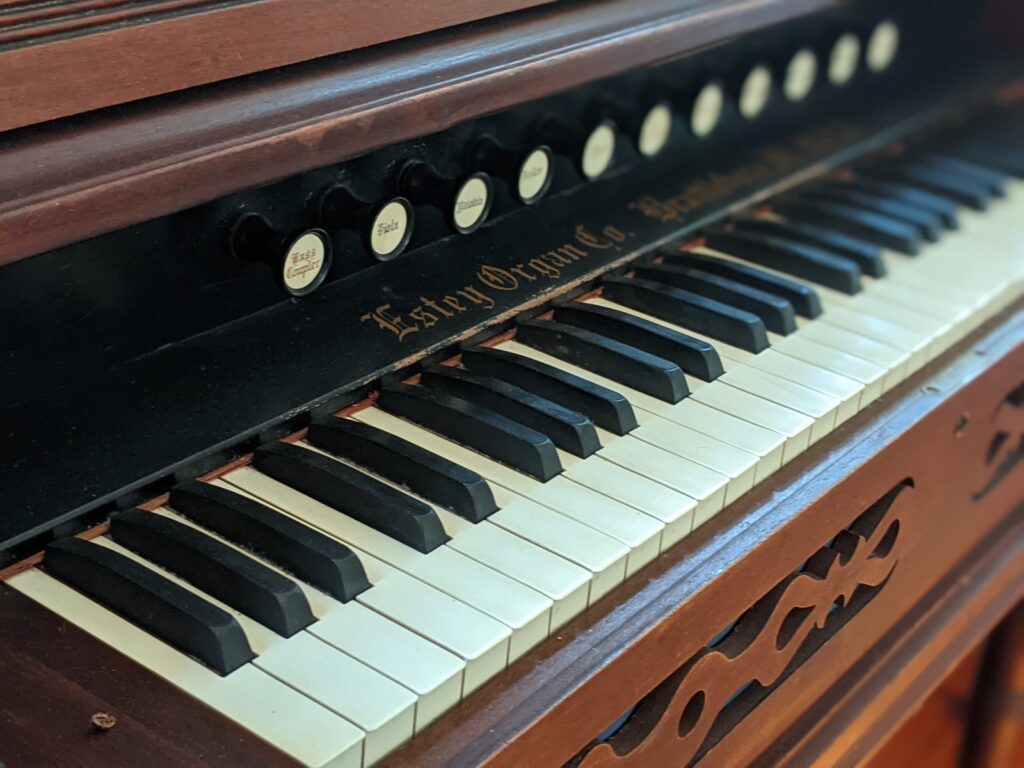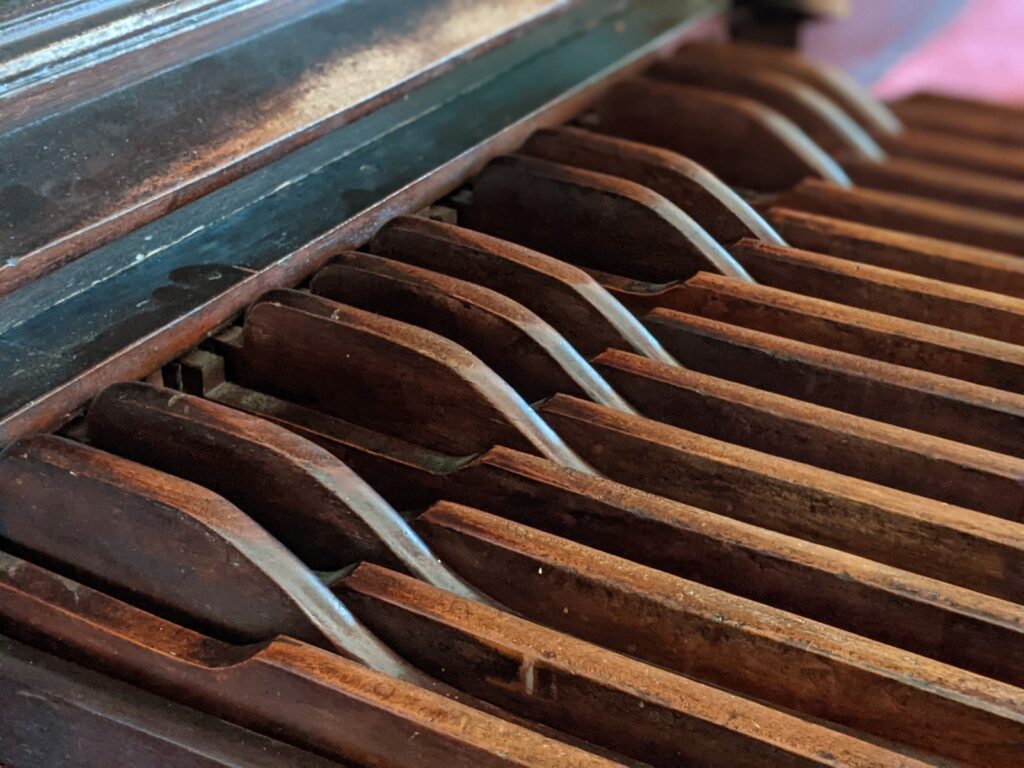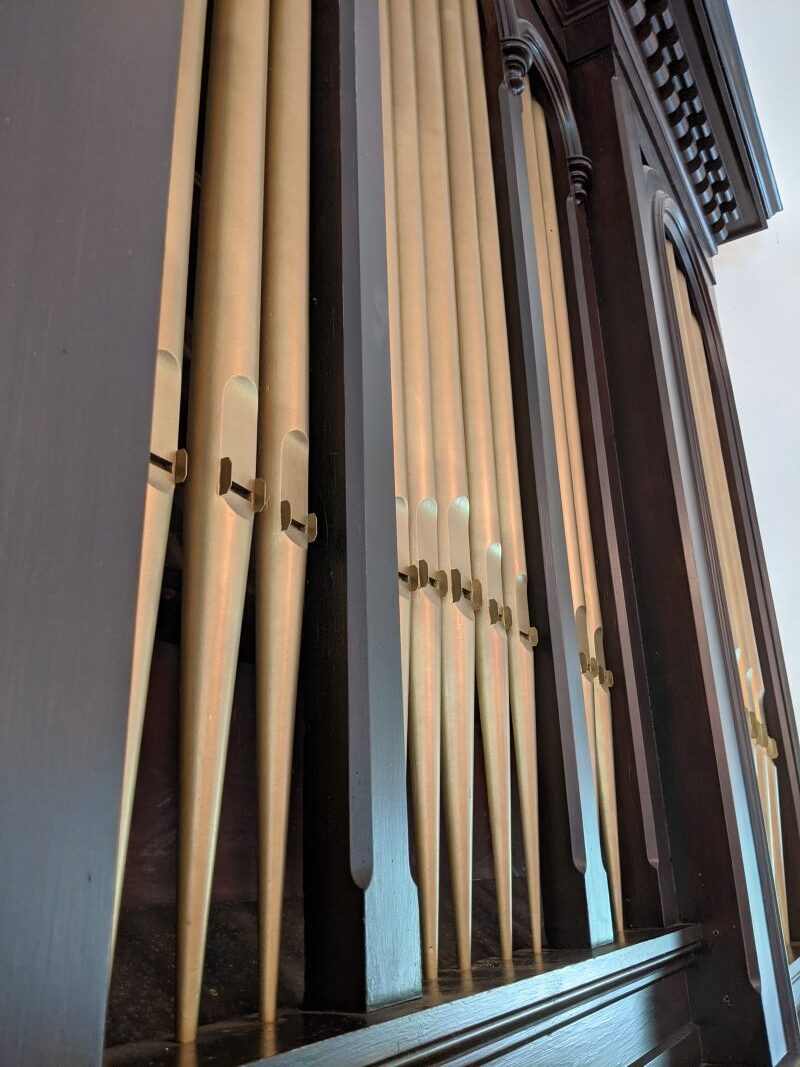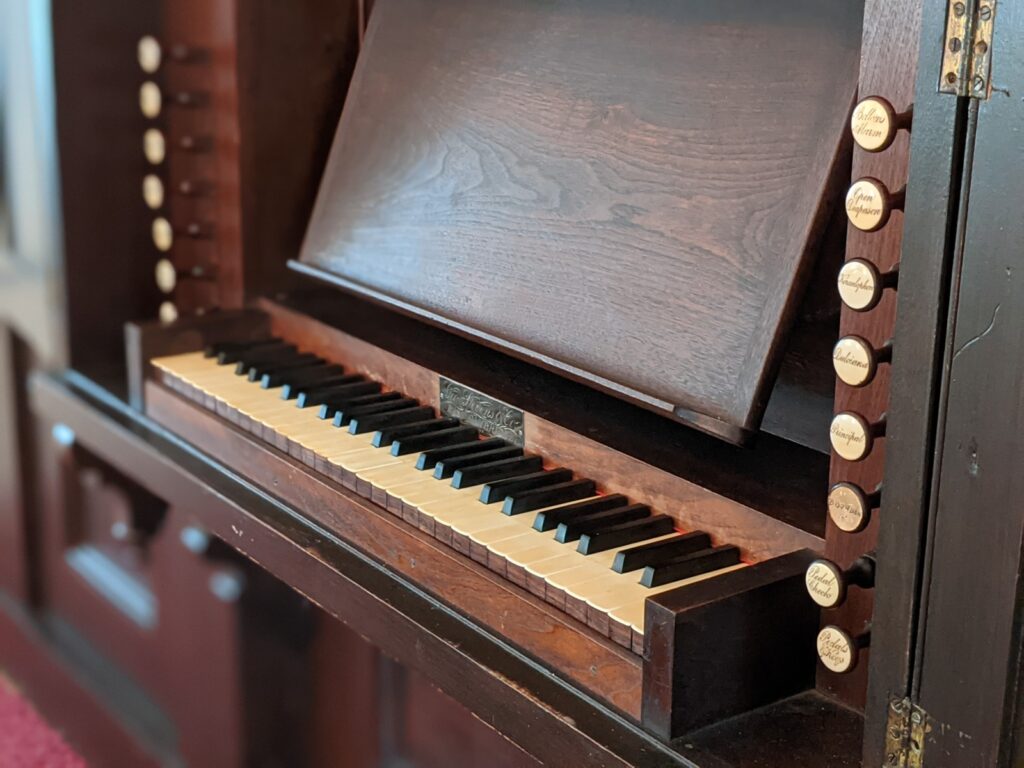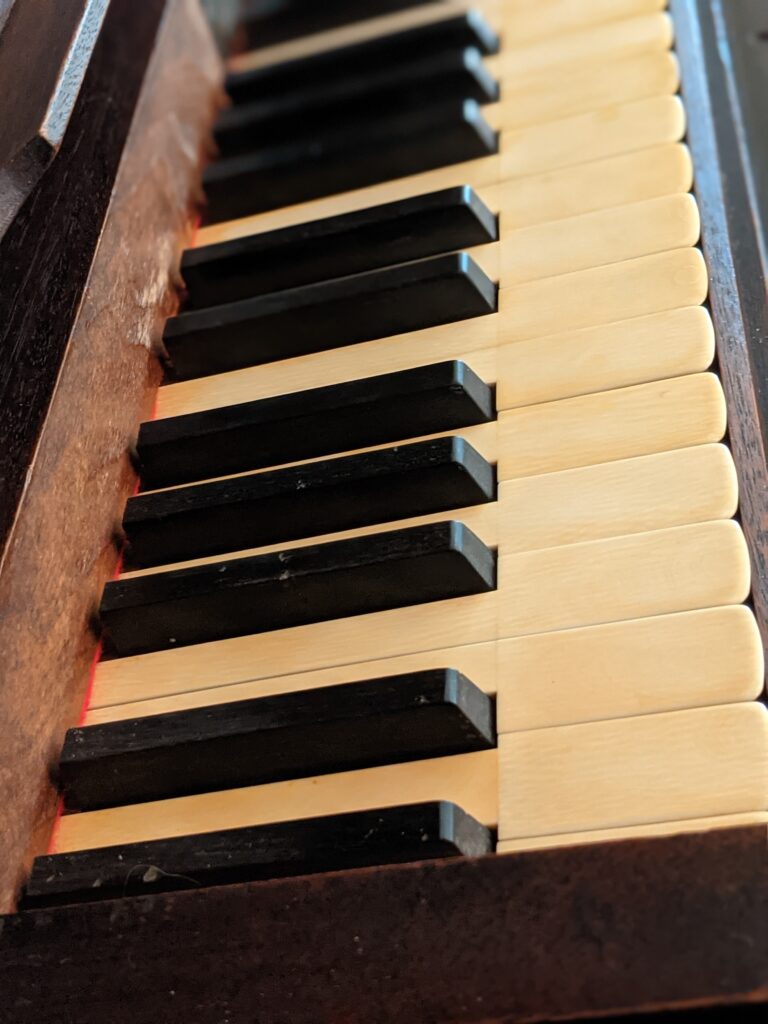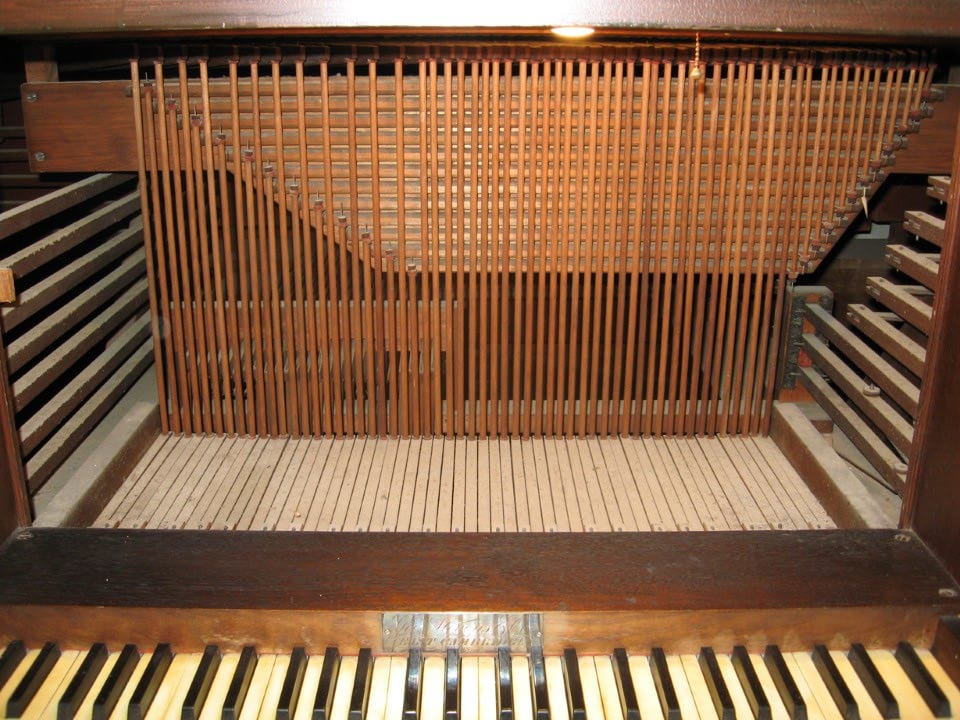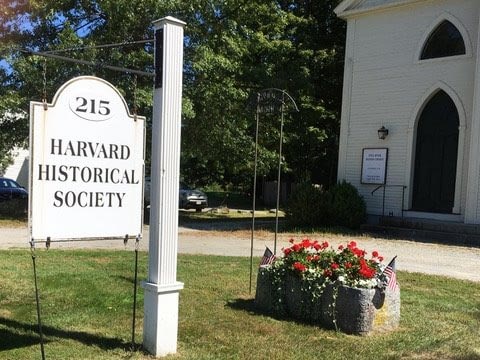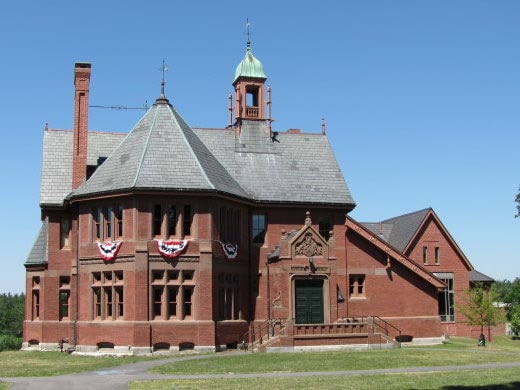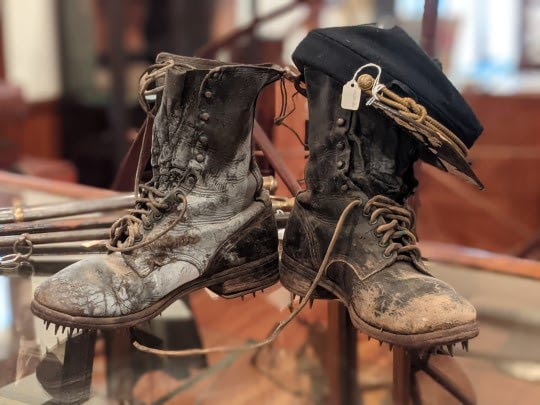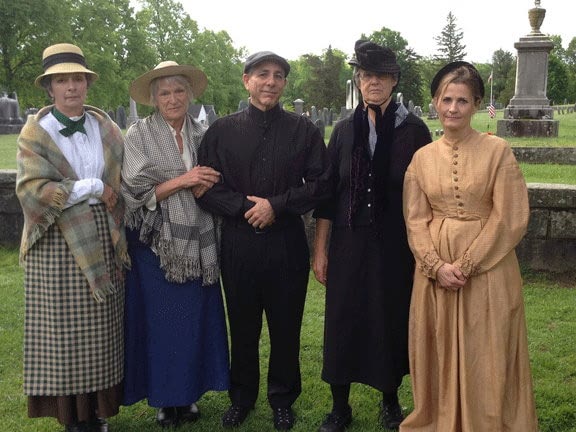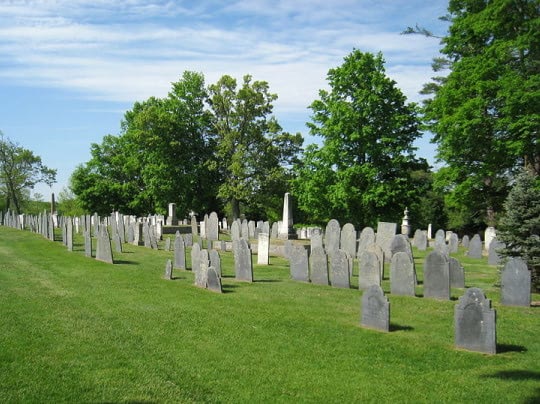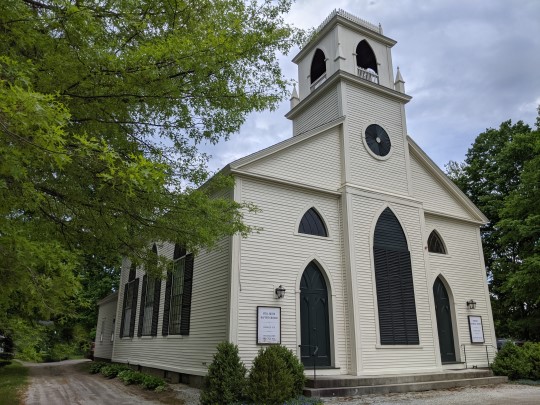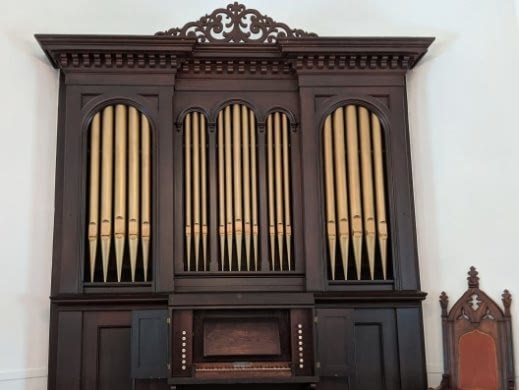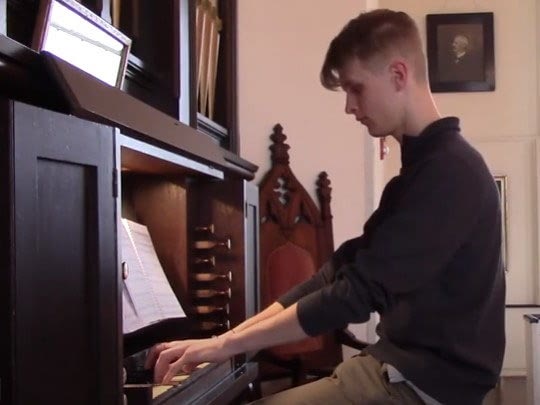The Organ
The 1870 George Stevens Pipe Organ
The organ was a gift to the Still River Baptist Society in 1870, by William Bowles Willard, a successful farmer and an influential member of the community. It's housed in the Still River Baptist Church. 2020 was the 150th anniversary of the historic organ. 2019 was the year the restoration of the organ began to bring it back to its full value.
Listen to the recitals on the restored organ or contact the curator to schedule your own experience with this unique and historic instrument.
Stewardship
In 1966, The Harvard Historical Society purchased the Still River Baptist Church. With the purchase of the building came a pipe organ that dominates the Western wall of the sanctuary.
The organ was given to the Still River Baptist Society in 1870 by William Bowles Willard, an influential member of the community who, for 57 years, served as clerk for the Baptist Society. The organ, valued at $1200-$1400, must have been a welcome and highly prized addition to the church to justify the sacrifices needed to accommodate it. Major renovations required the removal of the central portion of the choir loft to accommodate the organ. An apse was created around the organ and the remaining choir loft was condemned and walled off which meant obscuring important architectural elements such as the great window overlooking the valley below and gothic windows and upper sections of the doors. The choir was lowered to the level of the organ and the new configuration created a space with remarkable acoustic quality.
In 2006, the board of directors for the Harvard Historical Society decided to utilize the organ, which is arguably the largest artifact in the collection, other than the Meetinghouse. The Andover organ company who had once serviced the organ, repaired it and, after approximately 30 years of silence, the organ was heard by the public in a Society sponsored concert featuring organist Michael Kleinschmidt, then organist for Trinity Church in Boston.
Discovery of a historical gem
The 2006 concert sparked renewed interest in the organ and brought to light some important issues. Time had taken its toll. After 140 years of dust, deterioration, and disintegration, the organ was nearing the end of its practical serviceability. It could be made usable for the short term with repeated and costly service. The organ would need to be serviced before each event but could not return the organ to its full function. In order to play the organ in that condition, musicians would need to be flexible and sophisticated enough to work around non functioning elements.
Michael Kleinschmidt said that the organ appeared to be in original condition. The Andover organ company noted the same and offered to do a formal survey of its condition. It is extremely rare to find an organ from this era that has not been altered over time. In fact, Donald Olson, then president of Andover Organ Company described it as “kind of a miracle.” If a detailed survey confirmed Kleinschmidt's observation, it would give wider historical distinction to the organ itself, apart from its significance in local history.
While the survey was being conducted, the Society sponsored another concert, this time featuring organ historian, author, and organist Barbara Owen. Owen is a former president of the National Organ Historical Society, has authored several books on New England's organ history, and is a consultant on “matters pertaining to the organ.” She provided specific details of the organ and its construction and concurred that the organ’s condition appeared to be unaltered. Impressed with the possibility of seeing this unique organ restored and preserved Owen offered her expert services to the Society for free.
The true significance of the organ was recognized when the survey from the Andover Organ Company revealed that the organ was intact and unaltered from its original installation. It was also determined that a complete restoration of the instrument could be accomplished, would return the full splendor of its sound, and make it viable for future generations to enjoy. As Donald Olson, then president of Andover Organ Company explained, “with the restoration, the organ becomes reliable, quiet and will sound wonderful. It would be an example of what the organ was like when new.”
In May 2010, Barbara Owen returned to perform a concert at the Still River Meetinghouse. On this visit, she bestowed a citation, awarded by the Organ Historical Society to the 1870 George Stevens and Company organ, and honor its unique historical qualities. This citation directly acknowledges the historic value and authenticity of this instrument. As of February 2010, historic citations have been granted to 46 pipe organs in Massachusetts, 390 in North America and recognizes only three organs produced by a George Stevens Company. In addition, the Harvard Historical Society organ holds the distinction of being the largest remaining single manual organ produced by George Stevens. “Single manual” means that the organ has only one keyboard though this organ is unusually large and contains 585 pipes and 12 stops, each stop adding a unique tonal quality across the keyboard.
Restoring and preserving the organ
“What began as stewardship led to the discovery of a historic gem that should be restored and preserved.” Denis Wagner, former president of the Harvard Historical Society.
 Given the historical significance of the organ in the Still River Baptist Church and the historical significance of the organ as a unique and rare example of organ history, The Harvard Historical Society committed to having the organ restored.
Given the historical significance of the organ in the Still River Baptist Church and the historical significance of the organ as a unique and rare example of organ history, The Harvard Historical Society committed to having the organ restored.
The scope of the restoration called for the organ to be completely dismantled, removed from its location, cleaned, restored, and reinstalled. Extensive work would be done to the keyboard, peddle board, trackers, the bellows driven wind system, wind reservoir, and pipes, and a new blower installed. The organ was electrified in 1902 but can still be operated by its original hand pump.
The Harvard Historical Society would raise approximately $80,000 to complete the restoration and the organ would be restored by the Andover Organ Company. In order to reach this goal, the Society solicited funds from private donors and grant applications and enhanced the funds through investment dividends and interest. The Harvard Historical Society also hosted a number of series of accompanied silent films, and Playing with History concerts to raise funds and awareness about the organ and its need for restoration.
Now that the restoration is complete, the exceptional sound of this organ, coupled with the superior acoustics and historic nature of the church, offers a unique and desirable venue for the Society to expand its musical program offerings. In a letter to the Society, Richard Jones, former minister of the First Parish Church in Bolton MA, and former vice president of the Organ Historical Society wrote, “…one of the best things about the organ is the room it is in, I have rarely heard a better room for music. The sound of music in the Still River church is extraordinary…” Endorsements like this illustrate the potential for this organ and concert venue to serve as a significant asset in the Harvard and surrounding communities.
Historic value and authenticity
On May 23 2010, Barbara Owen performed on our 1870 George Stevens organ and presented a Historic Citation from the Organ Historical Society to recognize the significance of that organ.
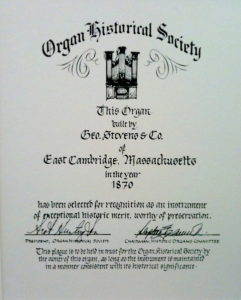 Barbara is a legend in the organ world with several books to her credit as well as many articles. She is an organist, historian, lecturer, past president of the Organ Historical Society, and librarian of the American Guild of Organists Organ Library at Boston University.
Barbara is a legend in the organ world with several books to her credit as well as many articles. She is an organist, historian, lecturer, past president of the Organ Historical Society, and librarian of the American Guild of Organists Organ Library at Boston University.
The citation is awarded by the Historic Organs Citations Committee of the Organ Historical Society to publicly honor pipe organs that possess special historic qualities.
As of February 2010, this distinction has been given to 390 organs in the United States and Canada, 46 of them in Massachusetts. Our organ is one of only three organs built by a George Stevens company to receive this honor.
The Harvard Historical Society 1870 George Stevens & Company organ holds the distinction of being the largest remaining single manual organ produced by George Stevens. In addition, the organ remains intact and unaltered from its original installation.
George Stevens (1803 – 1894) was a master craftsman and an important figure in American organ building. He also served as the third mayor of Cambridge, MA.
Stevens began his career as an apprentice for William Goodrich, a manufacturer of pipe organs in Cambridgeport. Goodrich is considered the father of the Boston school of organ building.
After Goodrich died in 1833, Stevens bought the firm with fellow employee M.R. Gayetty and operated as Stevens & Gayetty until 1839, when he formed his own company, George Stevens & Co.
Following George’s retirement in 1892, two of his employees continued its operation as Gilbert & Butler until it was dissolved in 1902.
Stevens built over 800 pipe organs throughout his career.
William Bowles Willard
In 1870, William Bowles Willard (1801-1891), lifelong resident of Still River, donated a pipe organ to the Still River Baptist Society. With that gift, he helped to enrich the community that surrounded him. Willard’s roots to this community were stronger than those of a single man. The seed had been planted and nurtured by five generations of Willards that preceded him.
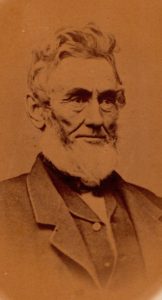
Major Simon Willard (1605-1676) was the first of his prolific new-world genealogical tree, emigrating to the colonies from Kent, England, around 1634. He married three times and fathered 17 children. He is a key historical figure in Massachusetts, considered instrumental in the founding of Concord and many
surrounding towns. The town fathers of Lancaster invited him to take up residence there, which he did in 1660. In 1672, he moved to Groton. The mansion he built there, at his Nonacoicus farm, was destroyed in 1676, when Nipmuc warriors raided Groton. He served as the chief military officer for Middlesex County and, according to historian Henry Nourse, “if the vote by which he was year after year elected Assistant may testify, the most popular magistrate in the colony.” At the outbreak of King Philip’s war, the Major, then 70 years of age, took command of the Middlesex soldiers.
Simon Willard’s fourth son, Henry (1655-1701), settled on his father’s land in Still River around 1687. According to a 1692 listing of Lancaster garrisons, he and his sons were a part of the eighth Lancaster garrison. Henry had nine sons, most of whom remained in the Harvard and Lancaster areas. Henry’s mother, Mary Dunster, was the third wife of Simon Willard and niece to Henry Dunster, the first president of Harvard College, who was forced to relinquish that position due to the openness of his sympathy to Baptist doctrine. Through this connection, according to Henry Nourse in History of the Town of Harvard, “It is alleged, and it is not an unreasonable supposition that Henry Willard and his sons, the first settlers at Still River, imbibed Baptist theological views from his mother” .
The Willard Family was well represented in the early days of the Harvard Baptist Society and remained active and influential over the years. Each new generation brought marriages to other prominent local families and by 1891, the fact that
most of the choir was connected with the family of William Bowles Willard is understandable, for at that time, it seems that a good number of the families in and around Still River had some connection to the Willard family tree.
William Bowles Willard, a direct descendant of Major Simon Willard, was born in 1802. In 1832 he married Abiah Woods Harrod (1802-1862), daughter of Captain Noah and Eusebia (Kendall) Harrod. Their union was a prime example of the intertwining of prominent Harvard families. They had seven children
together, six of whom lived to adulthood. After Abiah’s death, William married
Mrs. Maria (Paige) Gibson in 1863. She died four months later, and in 1864
he married Esther D. Metcalf.
William’s mother, Eleanor Bowles, had been the sole surviving member of a large Harvard family. Her father, Deacon William Bowles, her mother, and 13 siblings all died of consumption. William’s father, Abel Willard, was great grandson to Henry Willard.
If sympathy to Baptist doctrine did, in fact, begin with Henry Willard, his great-great grandson carried on the family tradition with honor. Bowles, as he was commonly called, or Uncle Bowles by those more familiar, was a pillar to the Still River Baptist Society, serving as its Clerk for 57 years. He was a successful farmer in Still River and, having ample means, was a generous benefactor for the Society and its missions. He contributed money to pay a large portion of the annual running expenses, helped to fund repairs, renovations, and additions to the church. He also contributed generously to charitable societies of his denomination, especially those connected with educating freed slaves in the South. The pipe organ he donated was a valued and significant gift. The organ was built by George Stevens, a master craftsman and respected Boston organ builder.
Prior to this time, the beloved choir had been accompanied by a small organ in the balcony choir loft, whose sound would have paled in comparison to the grand, richly toned pipe organs that had been installed in other local churches. Installing the massive organ, however, required major alterations to the rear of the church and the loss of a great window that overlooked the valley. It is possible, if not probable, that Bowles Willard funded these alterations as well. The fact that Bowles and the Society were willing to go to such great lengths and expense speaks, once again, to the importance placed on the choir.
Its dedication was noted in the Saturday, March 18, 1870, edition of the Clinton Courant, “The ‘seraphine’ in the Baptist church of Still River has at last given way to a modern Organ, generously given the society by Wm. B. Willard, Esq. Its value is estimated at some $1200 or $1400. It was to be dedicated last (Friday) evening by an Organ concert. Rev. Wm. Leach is acting pastor of the church.” With its dedication, the organ became officially woven into the fabric of the Still River Baptist community. At Sunday services, it provided the solemn melodies of worship and reflection. On occasions such as the marriage of Charlotte Willard, it sounded the sweet melodies of joy, hope, and new beginnings. On more somber occasions, such the funeral of William Bowles Willard himself, it sounded the bittersweet melodies of grief, sorrow, and loss.
Bowles Willard helped to support the Baptist Society even after his death, bequeathing them a healthy sum of $1,000. His widow, Esther, left another $500.
The Willard story is ongoing. Descendents of William Bowles Willard are present and prominent members of our community still, as are members of the Harrod family. The descendents of Major Simon Willard are spread throughout the country and are so numerous as to have their own Willard Family Association.


